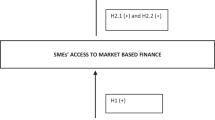Abstract
The article views the current financial crisis from the background of long term structural socio-economic changes in advanced industrial societies. Central points are the rise of the middle classes during the second half of the 20th century, the accumulation of financial wealth in the middle classes in combination with a continuing high and even increasing concentration of financial assets at the level of the top rich, and the advance of pension and investment funds as a new type of collective actors at global financial markets. These changes go parallel with an economic development which is characterized by increasing instability, declining growth rates and financial crises. The paper tries to clarify the interconnections between these phenomena in the framework of a multi-level analysis which culminates in the model of a “collective Buddenbrooks-effect”: A structural upward mobility of society will lead to an increasing imbalance at capital markets, since on the one hand the volume of financial assets searching for profitable investment will rise, whereas on the other hand the social reservoir of solvent debtors and promising investment opportunities will decline. Therefore, advanced industrial economies are characterized by a bias towards capital export and excessive financial liquidity, with the well known consequences of low economic growth rates and the danger of speculative bubbles at the global capital markets. The middle classes who originally benefitted from the post-war prosperity, are negatively affected too. The author argues that the current crisis cannot be understood sufficiently without taking account of these structural socio-economic backgrounds.
Similar content being viewed by others
Literatur
Birenheide, A., M. Fischer und A. Legnaro, 2005: Kapitalismus für alle. Aktien, Freiheit und Kontrolle, Münster.
Blomert, R., 2005: Das Ende der „neuen Ökonomie“. Eine finanzsoziologische Untersuchung, in: Berliner Journal für Soziologie, H., S. 179–198.
Blossfeld, Hans-Peter, 2006: Globalisierung, wachsende Unsicherheit und die Veränderung der Chancen der jungen Generation, in: Arbeit, 15. Jg., H. 3, S. 151–166.
Bude, H., 2008: Die Ausgeschlossenen. Das Ende vom Traum einer gerechten Gesellschaft, München.
De Bondt, W., 2005: The Values and Beliefs of European Investors, in: K. Knorr-Cetina und A. Preda (Hrsg.), The Sociology of Financial Markets, Oxford, S. 163–186.
Deutschmann, C., 2008: Kapitalistische Dynamik. Eine gesellschaftstheoretische Perspektive, Wiesbaden.
Esser, Hartmut, 1993: Soziologie. Allgemeine Grundlagen, Frankfurt a.M.
Esser, Hartmut, 1999: Soziologie. Spezielle Grundlagen. Band 1: Situationslogik und Handeln, Frankfurt a.M.
Fischer, L., T. Kutsch und E. Stephan (Hrsg.), 1999: Finanzpsychologie, München/Wien.
Ganßmann, Heiner, 2004: 30 Jahre Massenarbeitslosigkeit in der Bundesrepublik - ein deutscher Sonderweg, in: Leviathan 32, S. 164–184.
Geißler, R., 2006: Die Sozialstruktur Deutschlands, 4. Aufl., Wiesbaden.
Grewer, H.G., I. Matthäi und J. Reindl, 2007: Der innovative Ältere. Warum die Entwickleruhr länger als sieben Jahre tickt, München/Mering.
Grabka, M. und J. Frick, 2008: Schrumpfende Mittelschicht: Anzeichen einer dauerhaften Polarisierung der verfügbaren Einkommen? DIW-Wochenberichte 10, Berlin, S. 101–108.
Haubl, R., 2002: Money madness. Eine psychodynamische Skizze, in: C. Deutschmann (Hrsg.), Die gesellschaftliche Macht des Geldes, Leviathan-Sonderheft 21, S. 203–225.
Kindleberger, C. und R. Aliber, 2005: Manias, Panics and Crashes. A History of Financial Crises, 5. Aufl., Hoboken, N.J.
Knorr-Cetina, K., 2007: Economic Sociology and the Sociology of Finance. Four Distinctions, Two Developments, One Field?, in: Economic Sociology. The European Electronic Newsletter, Vol. 8/3, S. 4–10.
Nasaw, David, 2006: Andrew Carnegie, New York.
OECD, 2005: OECD, Statistics Portal, Institutional Investors Statistics, unter: www.oecd.org/.
Rügemer, Werner (Hrsg.), 2004: Die Berater. Ihr Wirken in Staat und Gesellschaft, Bielefeld.
Sassen, S., 2005: The Embeddedness of Electronic Markets: The Case of Global Capital Markets, in: K. Knorr-Cetina und A. Preda (Hrsg.), The Sociology of Financial Markets, Oxford, S. 17–37.
Schimank, Uwe und Ute Volkmann, 2008: Die Ökonomisierung der Gesellschaft, in: Andrea Maurer (Hrsg.), Handbuch der Wirtschaftssoziologie, Wiesbaden, S. 382–393.
Simmel, G., 1989: Philosophie des Geldes, Gesamtausgabe/Simmel, hsg. v. O. Rammstedt, Bd. 6, Frankfurt a.M. (Erstausgabe 1900).
Statistisches Bundesamt (Hrsg.), 2006: Datenreport 2006. Zahlen und Fakten über die Bundesrepublik Deutschland. In Zusammenarbeit mit dem Wissenschaftszentrum Berlin für Sozialforschung (WZB) und dem Zentrum für Umfragen, Methoden und Analysen Mannheim (ZUMA), Bonn.
Stein, H., 2004: Anatomie der Vermögensverteilung. Ergebnisse der Einkommens- und Verbrauchsstichproben 1983–1998, Berlin.
Szydlik, Marc, 2004: Zukünftige Vermögen - wachsende Ungleichheit, in: ders. (Hrsg.), Generation und Ungleichheit, Wiesbaden, S. 243–264.
Windolf, Paul, 1994: Die neuen Eigentümer. Eine Analyse des Marktes für Unternehmenskontrolle, in: Zeitschrift für Soziologie 23/2, S. 79–92.
Windolf, Paul, 2005: Was ist Finanzmarkt-Kapitalismus?, in: ders. (Hrsg.), Finanzmarkt-Kapitalismus. Analysen zum Wandel von Produktionsregimen, Sonderheft 45 der Kölner Zeitschrift für Soziologie und Sozialpsychologie, Wiesbaden, S. 20–57.
Author information
Authors and Affiliations
Additional information
gegenwärtig „Scholar-in-Residence“ am Max Planck-Institut für Gesellschaftsforschung in Köln; Mitherausgeber des Leviathan
Überarbeitete Version einer Vorlesung, die ich auf dem 34. Kongress der Deutschen Gesellschaft für Soziologie (DGS) in Jena (6.-10.10.2008) gehalten habe.
About this article
Cite this article
Deutschmann, C. Die Finanzmärkte und die Mittelschichten: der kollektive Buddenbrooks-Effekt. Leviathan 36, 501–517 (2008). https://doi.org/10.1007/s11578-008-0030-1
Published:
Issue Date:
DOI: https://doi.org/10.1007/s11578-008-0030-1




